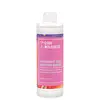What's inside
What's inside
 Key Ingredients
Key Ingredients

 Benefits
Benefits

 Concerns
Concerns

No concerns
 Ingredients Side-by-side
Ingredients Side-by-side

Water
Skin ConditioningGlycerin
HumectantButylene Glycol
HumectantSorbitol
HumectantEthoxydiglycol
HumectantPhenoxyethanol
PreservativeEthylhexylglycerin
Skin ConditioningPPG-26-Buteth-26
Skin ConditioningPEG-40 Hydrogenated Castor Oil
EmulsifyingCitric Acid
BufferingParfum
Masking3-O-Ethyl Ascorbic Acid
Skin ConditioningDisodium EDTA
Panthenol
Skin ConditioningSodium Hydroxide
BufferingGalactomyces Ferment Filtrate
HumectantNiacinamide
SmoothingPolysorbate 20
EmulsifyingRosa Canina Fruit Extract
AstringentAlcohol
AntimicrobialCitrus Aurantium Dulcis Peel Extract
Emulsion StabilisingCollagen Amino Acids
MoisturisingLinolenic Acid
CleansingOleic Acid
EmollientLinoleic Acid
CleansingCitrus Limon Peel Extract
EmollientLeuconostoc/Radish Root Ferment Filtrate
AntimicrobialSodium Hyaluronate
HumectantStearic Acid
CleansingTocopherol
AntioxidantPalmitic Acid
EmollientMyrica Rubra Fruit Extract
Skin ConditioningHydroxyacetophenone
AntioxidantSodium Benzoate
Masking1,2-Hexanediol
Skin ConditioningCaprylyl Glycol
EmollientAkebia Quinata Stem Extract
Skin ConditioningPrunus Lannesiana Flower Extract
Skin ConditioningHelianthus Annuus Seed Oil
EmollientLactobacillus Ferment Lysate
Skin ConditioningSaccharomyces Cerevisiae Extract
Skin ConditioningLimonene
PerfumingWater, Glycerin, Butylene Glycol, Sorbitol, Ethoxydiglycol, Phenoxyethanol, Ethylhexylglycerin, PPG-26-Buteth-26, PEG-40 Hydrogenated Castor Oil, Citric Acid, Parfum, 3-O-Ethyl Ascorbic Acid, Disodium EDTA, Panthenol, Sodium Hydroxide, Galactomyces Ferment Filtrate, Niacinamide, Polysorbate 20, Rosa Canina Fruit Extract, Alcohol, Citrus Aurantium Dulcis Peel Extract, Collagen Amino Acids, Linolenic Acid, Oleic Acid, Linoleic Acid, Citrus Limon Peel Extract, Leuconostoc/Radish Root Ferment Filtrate, Sodium Hyaluronate, Stearic Acid, Tocopherol, Palmitic Acid, Myrica Rubra Fruit Extract, Hydroxyacetophenone, Sodium Benzoate, 1,2-Hexanediol, Caprylyl Glycol, Akebia Quinata Stem Extract, Prunus Lannesiana Flower Extract, Helianthus Annuus Seed Oil, Lactobacillus Ferment Lysate, Saccharomyces Cerevisiae Extract, Limonene
Water
Skin ConditioningButylene Glycol
HumectantPropanediol
SolventGlycerin
Humectant1,2-Hexanediol
Skin ConditioningBetaine
HumectantHydroxyethyl Urea
HumectantHyaluronic Acid
HumectantSodium Hyaluronate
HumectantHydrolyzed Hyaluronic Acid
HumectantSodium Citrate
BufferingEthylhexylglycerin
Skin ConditioningCitric Acid
BufferingTrisodium Ethylenediamine Disuccinate
Tetradecyl Aminobutyroylvalylaminobutyric Urea Trifluoroacetate
Skin ConditioningMagnesium Chloride
Water, Butylene Glycol, Propanediol, Glycerin, 1,2-Hexanediol, Betaine, Hydroxyethyl Urea, Hyaluronic Acid, Sodium Hyaluronate, Hydrolyzed Hyaluronic Acid, Sodium Citrate, Ethylhexylglycerin, Citric Acid, Trisodium Ethylenediamine Disuccinate, Tetradecyl Aminobutyroylvalylaminobutyric Urea Trifluoroacetate, Magnesium Chloride
 Reviews
Reviews

Ingredients Explained
These ingredients are found in both products.
Ingredients higher up in an ingredient list are typically present in a larger amount.
1,2-Hexanediol is a synthetic liquid and another multi-functional powerhouse.
It is a:
- Humectant, drawing moisture into the skin
- Emollient, helping to soften skin
- Solvent, dispersing and stabilizing formulas
- Preservative booster, enhancing the antimicrobial activity of other preservatives
Butylene Glycol (or BG) is used within cosmetic products for a few different reasons:
Overall, Butylene Glycol is a safe and well-rounded ingredient that works well with other ingredients.
Though this ingredient works well with most skin types, some people with sensitive skin may experience a reaction such as allergic rashes, closed comedones, or itchiness.
Learn more about Butylene GlycolCitric Acid is an alpha hydroxy acid (AHA) naturally found in citrus fruits like oranges, lemons, and limes.
Like other AHAs, citric acid can exfoliate skin by breaking down the bonds that hold dead skin cells together. This helps reveal smoother and brighter skin underneath.
However, this exfoliating effect only happens at high concentrations (20%) which can be hard to find in cosmetic products.
Due to this, citric acid is usually included in small amounts as a pH adjuster. This helps keep products slightly more acidic and compatible with skin's natural pH.
In skincare formulas, citric acid can:
While it can provide some skin benefits, research shows lactic acid and glycolic acid are generally more effective and less irritating exfoliants.
Most citric acid used in skincare today is made by fermenting sugars (usually from molasses). This synthetic version is identical to the natural citrus form but easier to stabilize and use in formulations.
Read more about some other popular AHA's here:
Learn more about Citric AcidEthylhexylglycerin (we can't pronounce this either) is commonly used as a preservative and skin softener. It is derived from glyceryl.
You might see Ethylhexylglycerin often paired with other preservatives such as phenoxyethanol. Ethylhexylglycerin has been found to increase the effectiveness of these other preservatives.
Glycerin is already naturally found in your skin. It helps moisturize and protect your skin.
A study from 2016 found glycerin to be more effective as a humectant than AHAs and hyaluronic acid.
As a humectant, it helps the skin stay hydrated by pulling moisture to your skin. The low molecular weight of glycerin allows it to pull moisture into the deeper layers of your skin.
Hydrated skin improves your skin barrier; Your skin barrier helps protect against irritants and bacteria.
Glycerin has also been found to have antimicrobial and antiviral properties. Due to these properties, glycerin is often used in wound and burn treatments.
In cosmetics, glycerin is usually derived from plants such as soybean or palm. However, it can also be sourced from animals, such as tallow or animal fat.
This ingredient is organic, colorless, odorless, and non-toxic.
Glycerin is the name for this ingredient in American English. British English uses Glycerol/Glycerine.
Learn more about GlycerinSodium Hyaluronate is hyaluronic acid's salt form. It is commonly derived from the sodium salt of hyaluronic acid.
Like hyaluronic acid, it is great at holding water and acts as a humectant. This makes it a great skin hydrating ingredient.
Sodium Hyaluronate is naturally occurring in our bodies and is mostly found in eye fluid and joints.
These are some other common types of Hyaluronic Acid:
Learn more about Sodium HyaluronateWater. It's the most common cosmetic ingredient of all. You'll usually see it at the top of ingredient lists, meaning that it makes up the largest part of the product.
So why is it so popular? Water most often acts as a solvent - this means that it helps dissolve other ingredients into the formulation.
You'll also recognize water as that liquid we all need to stay alive. If you see this, drink a glass of water. Stay hydrated!
Learn more about Water